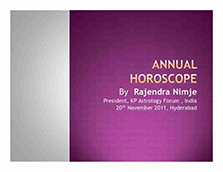
Prof. K.S. KRISHNAMURTI
1908-1972
Prof. Krishnamurti established through his research that the results of a planet in its period are strongly modified by the lord of the constellation in which it is posited according to the occupation, ownership, association, and aspects of the latter. He also realized that the difference in results should be attributed to the exact portion of the constellation occupied by the planet. For determining the zone of the constellation occupied by the planet, Krishnamurti divided the constellation in a significant and scientific manner, using the unequal Vimsottari proportion attributed to the venerable Sage Parashara.

He established through his research that the way house results are invoked by a planet is dictated by the lord of the division of the constellation in which the planet is posited (called the sub-lord) according to the occupation, ownership, etc., of the sub-lord. He also realized that the house cusp should be the starting point of the house and not the midpoint, as in Hindu astrology. Krishnamurti subjected the house-cusps to the method of constellation and sub. The planet owning either the constellation or the sub on the cusp of a house gives the results of the house, provided it is in a constellation and sub sympathetic to the matters of the house. Similarly, a planet posited in the constellation of the constellation lord or the sub-lord of the cusp of a house invokes the results of that house in the manner dictated by the planet’s sub-lord.
His method of prediction differs from traditional astrology, as he relied on the fast-moving house cusp rather than the slow-moving planets. He found that if the cusp is caught in the right sub, a thorough examination of the stellar position and disposition of the sub-lord would reveal the fate of the house correctly. He also explained the differences in the longevity, financial status, profession, etc., of twins through the sub-lords of the relevant cusps.
Prof. Krishnamurti extended his stellar technique to transits as well. The lords of the constellation and sub transited by the transiting planet explained the events accurately in terms of the houses they signify. His theory that the planets co-ruling the moment when a matter is taken up for examination with real urge will co-rule the moment of fructification of the matter as well is immensely helpful in pinpointing the time of occurrence of events.
- KP System gives importance to the Constellations / Stars / Nakshatras divisions of the Zodiac, which is considered to be the most precise.
- Each Constellation / Star / Nakshatra division is further divided into 9 unequal subdivisions called ‘SUBS’ based on the Vimshottari Dashas Divisions System.
- KP System uses KP ayanamshas instead of the Lahiri ayanamshas used in Vedic System, with a difference of about 6 minutes (Kala).
- Cusps, or house/bhav beginnings, are used instead of House Centres (Bhav Madhyas) in the Vedic System, similar to Western Systems.
- KP System uses the Placidus House system.
- The planet in its Dasha gives results as per its Star-Lord, rather than the planet itself.
- The planet represents the SOURCE, the planet’s Star-Lord represents the EFFECTS/RESULTS, and the planet’s Sub gives an idea of the FINAL DIRECTION of that result.
- KP System highly uses Ruling Planets methodology, which states that the planets at the time of desire and fructification are always the same.







